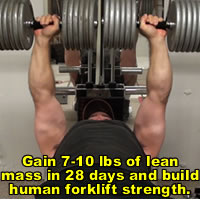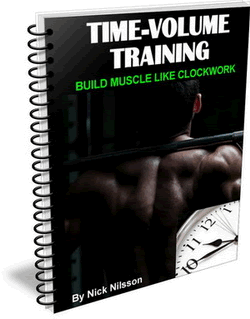I'm not going to tell you that you're benching wrong...but you could be doing it more right.
If you're not benching with your back, you could easily be leaving PLENTY of poundage on the table.
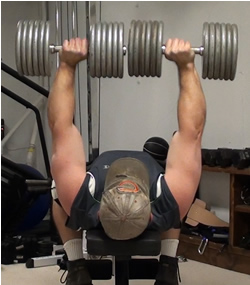
By using this "antagonist" muscle group properly while performing the bench press, you're going to immediately increase the power and stability of the exercise, allowing for some quick jumps in strength.
Here's the thing...a heavy press is a TOTAL BODY MOVEMENT. It's not just about chest, shoulders and arms.
And the sooner you realize that and TRAIN like that, the higher and faster your bench press numbers are going to climb.
Why You Should Bench Press With Your Back
1. Solidifying the Torso
One of the biggest mistakes people make with the bench press is not "solidifying" the torso during the press. Their shoulders are loose, their abdomen is relaxed...and they're literally throwing potential pounds out the window.
When performing a bench press, your torso should be ROCK SOLID. And your back plays a key role in this. By using your back to pull the shoulder blades back and tight, you immediately lock your torso into the movement.
2. Thickening the Torso for Shorter Range of Motion
Next point is, when you use your back to pull your shoulder blades in, this thickens your torso, reducing the range of motion of the exercise (remember, our goal here is maximum strength). The shorter the range of motion, the more weight you're going to be able to lift.
If you look at the setup of a strong bench presser, the goal is to shorten the range of motion as much as possible...the shoulders are back, the chest is out, and the lower back is arched. We're not looking for the same degree of arch as a top presser, but we DO want a similar body position in order to maximize strength.
3. Stronger Base of Support for Better Transfer of Power
The back also provides a strong base of support when benching (going back to the point about solidifying the torso). The tighter you can get your back, the stronger that base is going to be and the less "mooshing" of your torso there will be as the weight bears down on you.
And that means more efficient transfer of power out of the bottom...similar to the idea of wearing solid-soled thin shoes for deadlifting, or solid-heel Olympic lifting shoes for squats. You don't want soft...you want SOLID.
4. Shoulder Injury Prevention
I'll tell you right up front, the bench press gets a bad rap in terms of causing shoulder issues.
Not that the reputation is not well deserved, mind you...the bench press absolutely CAN cause shoulder issues.
That being said, though, one of the primary reasons that the bench press can cause shoulder issues, beyond just the mechanics of the movement itself, is HOW people perform the bench press. And this comes back to lack of lat contraction.
When you bench press and don't activate the lats, the pecs put a LOT of pull on the shoulder joint that IS NOT BALANCED by equal pull from the back muscles. Every time you bench press, you're then constantly torquing the shoulder joint.
It's no wonder people get shoulder issues from the bench press...these are issues that can sometimes be completely avoided simply by balancing the forces on the joint with concurrent activation of the lats.
Are there instances where even WITH lat activation the bench press can cause shoulder issues? Absolutely. I won't get into them here, but if you have had some issues with the bench press and you haven't spent the time learning how to contract the back properly while pressing, that might be the reason.
Or it might not be. You won't know until you try.
So let's move on...
How to Get Your Back into Your Bench Press
So it's all well and good to know WHY you should do it...now you need to know HOW.
|
First, put a light weight on the bar. I'm using 135 lbs in the demo here. It should be something you'd normally warm up with. I don't want you focusing on trying to press a weight as you're learning this technique...I want you to focus on the technique.
So a weight you can do easily is a MUST here.
Now, the way I like to get the back instantly into the correct position is very simple... perform a short inverted row movement on the bar.
To do this, just set your hands on the bar as you would for a normal press. Now, pull your torso up off the bench as though doing an inverted row (bodyweight row). Pull up, squeezing your shoulder blades together behind you (I like to visualize trying to pinch a quarter between my shoulder blades and holding it there).
This pulling in of the shoulder blades is known in biomechanical terms as "scapular retraction."
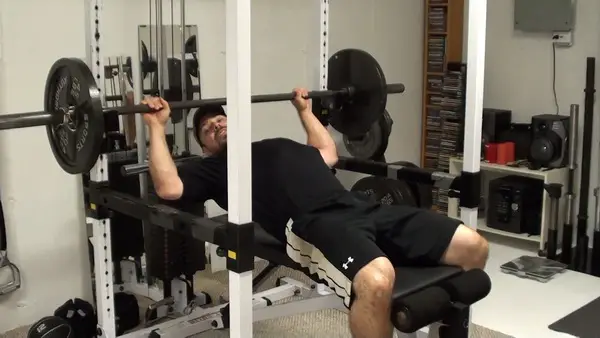
Now KEEPING THAT SHOULDER POSITION, set your torso back down onto the bench by straightening out ONLY your elbows. At this point, you should feel as thick as possible in the torso.
If you've never done this before, practice it a few times so you get the feel for it...pull yourself up, squeeze the shoulders together then set yourself on the bench.
Now you're ready to press.
Unrack the bar and DO NOT lose that shoulder position. If they did flatten out, hold at the top and get them squeezed back into position. It'll take a bit of practice to keep the shoulders locked back as you unrack the bar, so don't worry if you don't get it perfect right away. Just keep practicing every time you bench.
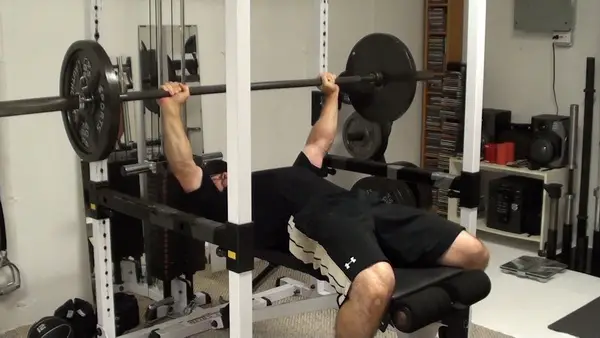
Take a DEEP breath in then begin to lower the bar under control.
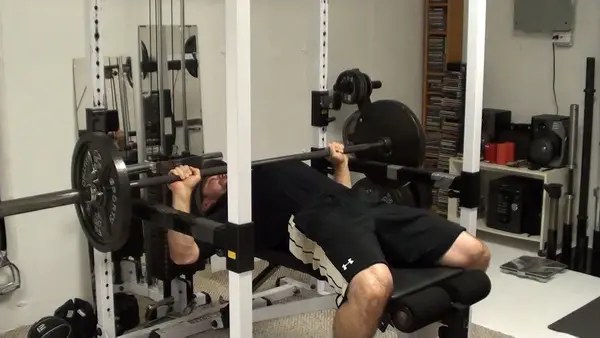
And we come to the next point...as you're lowering the bar, you want to further activate the lats by pushing outwards on the bar with your hands, i.e. trying to "spread" the bar out. This will force the lats to contract, reinforcing that "solid" back contraction on the way down. You can also consciously contract the lats on the way down, in addition to this "spreading" of the bar.
Now comes the tricky part...
It's tricky, because as you press up, the contraction of the pecs is going to make the shoulders want to come away from each other and spread out (the biomechanical term is protraction). This flattens out the torso and softens your back, so to speak, when the goal is keeping the torso solid.
It's definitely something we want to avoid, if we can.
As you press, I DON'T want you to think about pushing the bar up.
I want you to think about pushing YOURSELF down away from the bar, down through the bench, as hard as possible, while keep your back solid.
It's a very small shift in perspective but it will pay BIG dividends as you press the bar. This shift in perspective I find helps me maintain that shoulders-in position better than focusing on pushing the bar away. You'll still need to keep your mind in the game to keep those shoulders in as much as possible, but this mental shift helps a lot.
Now, this shoulders-in position gets tougher to maintain as you come to the top of the movement as the natural tendency will be for the shoulders to protract in order to get the "full range of motion" that you're used to.
Your job is to FIGHT this and do your best to keep your shoulders back and in.
Focus on locking out the elbows, not on pushing so far up that your shoulders come forward, flattening out your back.
At this point, I want you to rerack the weight. Only do ONE rep. Take a moment and think about what you just did and think about whether you succeeded or failed at maintaining that shoulders-in position for as much of the rep as possible.
Now, get back under the bar and do it again, adjusting your form and mental focus if you didn't nail it the first time. We're looking for perfect practice here.
Once you can successfully engage the back muscles during all phases of the bench press for several single reps in a row, THEN you can move up to your normal training weights and press...and feel the difference.
And trust me...you WILL feel the difference.
The Bottom Line...
Next bench day, before you get into your regular loads, take a few minutes to work with these techniques and really teach your body how to use the muscles of the back. It's time well spent.
Nobody jumps on a bench press bench and presses perfectly the first time through. As simple as the exercise looks, there are a lot of form and body position technique points that, when put into practice, can help you make dramatic gains in strength and help you avoid injury at the same time.
![]()
More From Fitstep.com
Share This Page...
---
Home -> Exercise Library -> Chest Exercises -> Use Your Back


